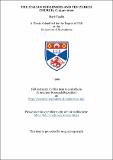Files in this item
The Italian reformers and the Zurich church, c.1540-1620
Item metadata
| dc.contributor.advisor | Gordon, Bruce | |
| dc.contributor.author | Taplin, Mark | |
| dc.coverage.spatial | 340 p. | en_US |
| dc.date.accessioned | 2018-05-31T08:17:27Z | |
| dc.date.available | 2018-05-31T08:17:27Z | |
| dc.date.issued | 1999-07 | |
| dc.identifier.uri | https://hdl.handle.net/10023/13632 | |
| dc.description.abstract | This study charts the developing relationship between the Zurich church and Italian-speaking Protestants between around 1540 and 1620. It explores the close ties that were established between Zurich's senior minister, Heinrich Bullinger, and Italian evangelical exiles in Switzerland and elsewhere from the early 1540s, and describes how the Zurich church facilitated the spread of Protestantism in Italian-speaking regions such as Locarno and southern Graubünden. That process culminated in the setting-up in Zurich, under Bullinger's patronage, of an Italian Reformed congregation. A particular concern of the thesis is the threat to the integrity of the Zwinglian settlement posed by the ideas and activities of religious radicals within the Italian exile community. To begin with, Bullinger was confident that those 'heretics' could be accommodated within the emerging Reformed consensus. However, a series of doctrinal disputes during the 1540s, 1550s and 1560s revealed the extent of the radicals' differences with Reformed orthodoxy and compelled the Zurichers to revise their judgement. Bullinger's hostile reaction to the publication of the allegedly heterodox Dialogi XXX by his Italian colleague, Bernardino Ochino, signalled a move from conciliation to confrontation. From the early 1560s, the Zurich divines assumed an active role in the Reformed campaign to shore up Nicene orthodoxy against the criticisms of Italian antitrinitarians, and to expel radicals from the Italian-speaking churches of the Rhaetian Freestate. In the process, they endeavoured to counter the charges of heresy that had long bedevilled Zwinglianism by articulating a conservative, 'catholic' definition of their church's identity. The study concludes by examining how relations between the Zurich church and the Italian Reformed communities of Graubünden and its subject lands were placed on a new, co-operative basis once the radical challenge had been repelled. Through its support for those vulnerable congregations, I suggest, the Zurich church gave evidence of its continued commitment to the international Protestant cause during the period following Bullinger's death. The correspondence of Bullinger and other Zurich ministers forms the dissertation's most important source. The study also draws on works produced by the Zurich divines in the context of their exchanges with Italian evangelicals, the works of the Italian exiles themselves, and the records of Zurich's Italian-speaking community. | en_US |
| dc.language.iso | en | en_US |
| dc.publisher | University of St Andrews | |
| dc.subject.lcc | BX8026.Z9T2 | en |
| dc.subject.lcsh | Reformation--Switzerland--Zurich | en |
| dc.subject.lcsh | Italians--Switzerland--Zurich--History | en |
| dc.subject.lcsh | Zurich (Switzerland)--Church history | en |
| dc.title | The Italian reformers and the Zurich church, c.1540-1620 | en_US |
| dc.type | Thesis | en_US |
| dc.contributor.sponsor | British Academy | en_US |
| dc.contributor.sponsor | St Andrews Reformation Studies Institute | en_US |
| dc.contributor.sponsor | Royal Historical Society (Great Britain) | en_US |
| dc.type.qualificationlevel | Doctoral | en_US |
| dc.type.qualificationname | PhD Doctor of Philosophy | en_US |
| dc.publisher.institution | The University of St Andrews | en_US |
This item appears in the following Collection(s)
Items in the St Andrews Research Repository are protected by copyright, with all rights reserved, unless otherwise indicated.

